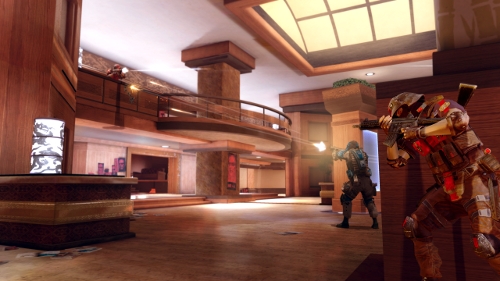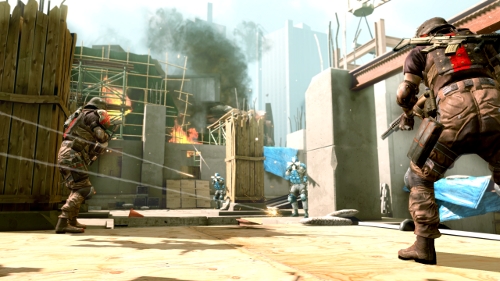Control
As with so many other king-of-the-hill type modes, the focus of The 40th Day’s Control mode is for one team of four to occupy a certain point for a set period of time. Once one control point has been captured, a new one generates somewhere on the map and the process continues until one team reaches the predetermined number of points and wins the match. A circle with two bars extending from it keep track of the progress of how far along a team is to capturing the control point; the more members of a team that are occupying the control point, the faster it fills up. Opposing team members standing in the control point cause progress to halt and should all members of the leading team be removed from the control point, their progress starts to diminish and the usurping team’s bar starts to fills. This visual representation of a team’s progress leads to an overall “tug-of-war” feeling to the match. As that bar edges ever closer to one side, the opposing team is not without hope of snatching victory away at the last minute through a well-coordinated team attack that ousts the controlling team and establishes a firm defense to stave off the eventual counterattack. Once again, EA Montreal showed how truly co-operative a competitive mode can be with the right mix of game mechanics.

Making use of flanking tactics is a quick and easy way to bring down an enemy force
Warzone
If you played any of the multiplayer modes from the previous Army of Two, you likely are familiar with Warzone, which pits two teams of up to four players against one another in alternating attack/defend scenarios. At the start of a match, one team is given an objective, such as plant a bomb, kill the VIPs, or capture the intel, while the opposing team is given the counter-objective, i.e., defend the position/VIPs/intel. The attacking team’s objective must be completed within a certain amount of time otherwise the defending team gets a point. Whatever the resolution, once a team scores a point, each team is given a new objective and the timer starts over again. This shifting of objectives, as well as shifting of who’s on the attack and who’s on the defense, helps keep the match fresh and lends that same tug-of-war feeling that was present in Control.
As I mentioned earlier, our group played all of these modes in the same room, side-by-side, shouting and encouraging other the whole way through. I somehow have a hard time imagining having as much fun as I did if we were all playing over the Internet talking into headsets as such a method of play would make it hard to high-five and fist bump our victories. Indeed, the one feature present in the single-player campaign that felt oddly missing was the ability to have your in-game avatars congratulate one another in a similar fashion. Still, whether it’s on the couch or over the web, The 40th Day’s multiplayer modes were a blast to play and just as fun and co-op focused as the single-player parts Jim and I got to play back at PAX.

The eternal struggle between red and blue continues...
With all of four of the multiplayer modes tackled, our group was treated to a new, never-before-shown single-player level. However, the details of that will have to wait just a little while longer. Be sure to check back here at Co-Optimus over the next few days for new details, some more impressions, and the answers to all the questions you had for the Army of Two: The 40th Day developers!